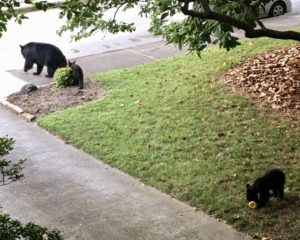Yes, we do have black bears in Asheville, NC. You won’t see them strolling around downtown but they do live within the city limits. We had a lot of bear activity this past summer in my neighborhood. And it’s an urban environment within this small city. These videos were filmed where the houses are fairly close together, there are sidewalks, street lights and so forth. All the videos in this post I took in July of this year (2019).
Close encounters with the bears in Asheville…
This summer, a mother bear and her two cubs were frequent visitors. You can’t always get a good photo or video because often they are just traveling through and are gone quickly. The first close bear encounter I had was years ago, and very fleeting but memorable. Walking my small dog one evening I saw movement out of the corner of my eye. A very large bear barreled across the street and ran across the sidewalk about 10-15 feet in front of us. That was about 4 years ago. We see them more often now.
NC Urban Bear Study
The NC Wildlife Resources Commission has partnered with North Carolina State University to conduct the NC Urban Bear Study in Asheville. It began in 2014 and is expected to continue through next year before they gather and release all of their findings. The researchers capture, collar, release and track the bears. Asheville residents have been cooperating with the teams to allow big barrel traps on their property. The study has their own Facebook page that you can find here, with more information and pictures. They explain they’re going to be looking at population, survival rates, mortality causes, their range/movements and reproduction. I’m curious as to why the bears are coexisting with us. Is it due to our land development and disruption of their habitats or have they decided to move into or stay in a more urban setting because they can find convenient food sources?
According to a recent article about the study in the Asheville Citizen-Times, the largest bear they captured was a male weighing in at 542 pounds. So big in fact, they couldn’t collar him because they didn’t have one big enough. But the bears, at least in the preliminary findings, seem to be doing quite well in this urban environment. Reproductive patterns seem quite normal and most bears don’t even leave the city limits to den over the winter. Within the city limits, there is no hunting, so the greatest cause for injuries and deaths has been motor vehicle accidents, but it hasn’t been prevalent.
Learning to Adjust
There is also an informative short film from UNC-TV on the study. The film relates how bears seem to be extremely tolerant of people. I can agree with that. I know there was never a moment that the mother bear wasn’t aware of our presence on the day I filmed the above clips. But we kept our dog inside, didn’t try to get too close or have them feel threatened in any way. As they say in the UNC-TV video, it is much more a people management issue rather than a bear management issue. We need to adjust and learn some basic habits. The use of bird feeders is discouraged, no keeping pet food outside, keeping grills clean and trying to keep trash and recycling secure. You don’t hear them approaching, so when I am walking my dog, I keep a watchful eye around.

As the film states, black bears are native to North Carolina. But their numbers had drastically dwindled by the 1970’s. Thanks to wildlife conservation measures their numbers have now grown substantially. They are magnificent creatures and it is a bit of a thrill to see them. But showing them respect and giving them their space goes a long way to keeping everyone safe.

Leave a Reply